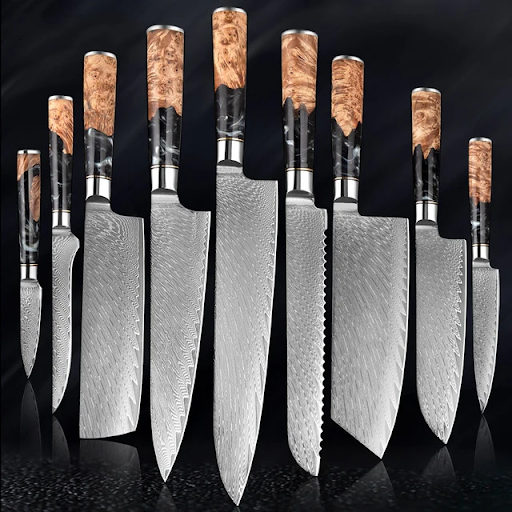Japanese kitchen knives are masterpieces of culinary engineering. Each one blends time-honored craftsmanship with today’s best metallurgy, creating cutting tools that upgrade any kitchen. Yet owning a fine Japanese chef knife means committing to the right upkeep. This care is the only way to keep their legendary sharpness and long-lasting beauty.
While big-box knife sets are largely mass-produced, Japanese knives demand the kind of attention that matches their quality. These blades are shaped by specific metal chemistry and unique construction techniques. It doesn’t matter if you bought one stunning gyuto or a full Nagasaki artisan collection; understanding upkeep will make sure your knives keep slicing, mincing, and dicing the way they did the day you unwrapped them.
To make knife care straightforward, we’ve gathered the steps you can use every single day, as well as the techniques only pros need. Shifting gears to day-to-day cleaning, honing, and occasional sharpening will protect your investment and keep the cutting performance that earns these knives global praise from chefs. Japanese Knife Steel
Japanese blades generally use one of three types of steel: carbon steel, stainless steel, or the layered beauty of Damascus. Each kind has its own personality, and your approach should shift depending on which is in your hand.
Carbon steel knives slice boxes to cheese with outstanding sharpness. That excellence comes with a downside: rust loves to hitch a ride on unclean uncoated carbon blades. Give them a rinse and a dry right after you cook, though, and a thin, tough layer of iron oxide, often called patina, starts to form. Don’t scrub it away—this dark finish is nature’s own rust-resistant shield.
Stainless steel Japanese knives, on the other hand, have blade metal fortunes written in alloy. These knives resist the moisture and acid of day-to-day cutting without losing the hair-fine sharpness seen on steel from Kyoto to your cutting board. In fast-paced kitchens, where one pan washes, dries, and gets shoved aside before you have a sip of water, their quick-rinsing nature saves tired prep hands.
A beautiful Damascus steel blade is like a work of art that slices as pretty as it looks. Layers of soft and hard steel, forged into ripples that resemble wood grain, create a deeply sweet pattern. Inside that art often hides a hard carbon steel center, with soft stainless steel hugging it like a bubble wrap of protection. The look is stunning, but the knife needs some rust-proof respect along with its beauty.
Knowing what your metal is made of helps you draw the right knife-care map. If you have a carbon, stainless, or Damascus blade in your drawer, you’ll know the frequency and the force of scrubbing to keep its inky deeds aboard a cutting board and not crowding your knife rack.
Pay special attention to the heel area where the blade meets the handle; this is where food bits tend to gather. For crusty residue, a quick dip in warm, soapy water works, but don’t let the knife sit in water for long.
Steer clear of abrasive pads and steel wool. They can scratch the blade and ruin its cutting ability. Instead, mix baking soda with a bit of water to form a paste, and use that to scrub away stains on carbon steel edges.
Quick Drying and Top-Notch Storage
Drying the knife right away is a must, especially for carbon steel. Grab a soft, clean towel and wipe the blade and handle, getting into every tiny joint to leave no water behind.
Magnetic strips are a gorgeous way to hang and protect your blades. They grip securely, so the edges stay sharp, and the open style keeps air moving to stop humidity from working its magic. A knife block is handy, too, as long as the slots fit perfectly; never jam a blade into a space that’s too tight. When using drawers, slide on knife guards or blade covers to keep edges safe and avoid surprises.
Never toss knives into a drawer with forks, spoons, and loose gadgets. When handles clank and blades bump, chips and rough spots ruin the cutting edge, and the next slice through a tomato might sting more than expected. Investing in a magnetic strip, blade guard, or in-drawer tray will sooner or later prove worthwhile.
Honing Your Japanese Knives
To keep a Japanese blade flashing between trips to the whetstone, we persuade the edge back into alignment rather than grind it away. Think of this minor carpentry of chores: it gently nudges the edge without inviting more metal to the party.
Most Japanese blades want this gentle nudge every couple of meals. Frequent Prep cooks may reach for a ballerina-ready edge every week, while home cooks serving chicken-or-salad once a week will still see feather-light wear with every board of avocado.
Steels, generally, lunch a blade agenda to jagged downtown. Give a ceramic rod or a whetstone in the 6000-8000 grit neighborhood the night instead. Pick the fix with the lightest pass.
Rest the blade at the 15-17 degrees the knife prefers like a window on the open angle—Hemispheric architects, rejoice! When compared with a 20-22 degree chassis of West-side blades, this angle requires search light-focus.
Pair the blade to the move: heel to tip, like a zipper. Repeat the journey on the flip side. Three to five a side makes gardeners come in zip.
When to sharpen
Even the knighted main chef of the J chef melanlayer landscape—sashimi-trust-fust of Kimura—one day to see the concern.
Notice tomato mush brightening the land; herbs crush like sadness; onions, once sworn enemies of trick ears, whisper slippery pick. Such heartbreak requires a whet to realign the morale without the slightest nudge toward crooked integrity.
Whetstones are still the best way to sharpen Japanese knives. For a blade that feels really dull, begin with a stone that’s 400 to 800 grit. For the average maintenance, move to a 1000 to 3000 grit. Finally, a stone over 6000 grit brings a mirror shine to the edge.
Before you start, soak the water stone in a basin for 10 to 15 minutes. Keep the sharpening angle steady the whole time—Finesse is crucial, since the same shallow angles that let the knife slice so well also make it easy to over-sharpen or damage the edge.
If the knife is heavily chipped or feels like it has lost its curve, a professional service knows how to mirror the original Japanese geometry and return the blade to like-new conditions.







